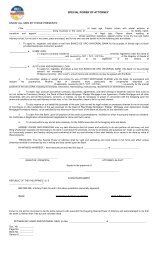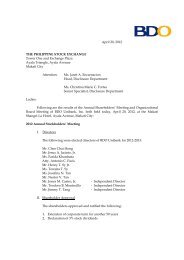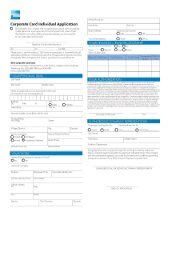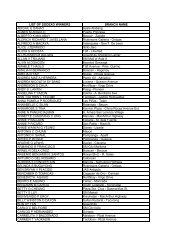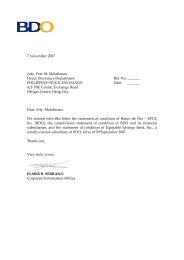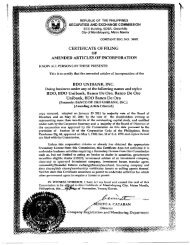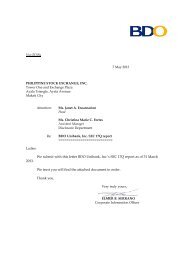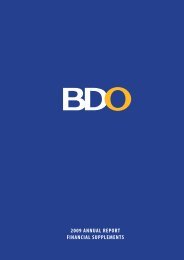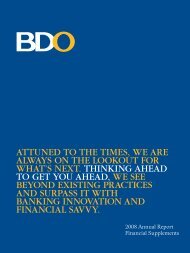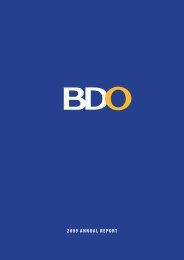Via ODiSy March 22, 2012 PHILIPPINE STOCK EXCHANGE ... - BDO
Via ODiSy March 22, 2012 PHILIPPINE STOCK EXCHANGE ... - BDO
Via ODiSy March 22, 2012 PHILIPPINE STOCK EXCHANGE ... - BDO
- No tags were found...
Create successful ePaper yourself
Turn your PDF publications into a flip-book with our unique Google optimized e-Paper software.
2.23 Impairment of Financial Assets- 27 -<strong>BDO</strong> Unibank Group assesses at the end of each reporting period whether there isobjective evidence that a financial asset or group of financial assets is impaired. Afinancial asset or a group of financial assets is impaired and impairment losses areincurred if, and only if, there is objective evidence of impairment as a result of one ormore events that occurred after the initial recognition of the asset (a loss event) and thatloss event has an impact on the estimated future cash flows of the financial asset or groupof financial assets that can be reliably estimated. Objective evidence that a financial assetor group of assets is impaired includes observable data that comes to the attention of<strong>BDO</strong> Unibank Group about certain loss events, including, among others: (i) significantfinancial difficulty of the issuer or debtor; (ii) a breach of contract, such as a default ordelinquency in interest or principal payments; (iii) the probability that the borrower willenter bankruptcy or other financial reorganization; (iv) the disappearance of an activemarket for that financial asset because of financial difficulties; or, (v) observable dataindicating that there is a measurable decrease in the estimated future cash flows from agroup of financial assets since the initial recognition of those assets, although the decreasecannot yet be identified with the individual financial assets in the group.(a) Assets carried at amortized cost. <strong>BDO</strong> Unibank Group first assesses whether objectiveevidence of impairment exists individually for financial assets that are individuallysignificant and individually or collectively for financial assets that are notindividually significant. If <strong>BDO</strong> Unibank Group determines that no objectiveevidence of impairment exists for an individually assessed financial asset, whethersignificant or not, <strong>BDO</strong> Unibank Group includes the asset in a group of financialassets with similar credit risk characteristics and collectively assesses them forimpairment. Assets that are individually assessed for impairment and for which animpairment loss is or continues to be recognized are not included in a collectiveassessment of impairment.If there is objective evidence that an impairment loss on loans and receivable orHTM investments carried at amortized cost has been incurred, the amount of theloss is measured as the difference between the asset’s carrying amount and thepresent value of estimated future cash flows (excluding future credit losses that havenot been incurred) discounted at the financial asset’s original effective interest rate.The carrying amount of the asset is reduced through the use of an allowanceaccount and the amount of the loss is recognized in profit or loss. If a loan orHTM investment has a variable interest rate, the discount rate for measuring anyimpairment loss is the current effective interest rate determined under the contract.When practicable, <strong>BDO</strong> Unibank Group may measure impairment on the basis ofan instrument’s fair value using an observable market price.The calculation of the present value of the estimated future cash flows of acollateralized financial asset reflects the cash flows that may result from foreclosure lesscosts for obtaining and selling the collateral, whether or not foreclosure is probable.For the purpose of a collective evaluation of impairment, financial assets aregrouped on the basis of similar credit risk characteristics, i.e., on the basis of <strong>BDO</strong>Unibank Group’s or BSP’s grading process that considers asset type, industry,collateral type, status and other relevant factors. Those characteristics are relevantto the estimation of future cash flows for groups of such assets by being indicativeof the debtors’ ability to pay all amounts due according to the contractual terms ofthe assets being evaluated.



